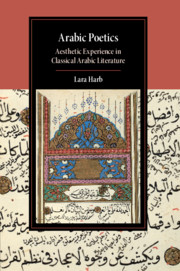Book contents
- Arabic Poetics
- Cambridge Studies in Islamic Civilization
- Arabic Poetics
- Copyright page
- Dedication
- Contents
- Preface
- Acknowledgments
- Note on Dates, Translations, Transliterations, and Names
- Introduction
- 1 Wonder
- 2 Wonder in Aristotelian Arabic Poetics
- 3 Discovery in Bayān
- 4 Metaphor and the Aesthetics of the Sign
- 5 Naẓm, Wonder, and the Inimitability of the Quran
- Epilogue
- Conclusion
- Bibliography
- Index
- Other Titles in the Series
3 - Discovery in Bayān
Published online by Cambridge University Press: 24 April 2020
- Arabic Poetics
- Cambridge Studies in Islamic Civilization
- Arabic Poetics
- Copyright page
- Dedication
- Contents
- Preface
- Acknowledgments
- Note on Dates, Translations, Transliterations, and Names
- Introduction
- 1 Wonder
- 2 Wonder in Aristotelian Arabic Poetics
- 3 Discovery in Bayān
- 4 Metaphor and the Aesthetics of the Sign
- 5 Naẓm, Wonder, and the Inimitability of the Quran
- Epilogue
- Conclusion
- Bibliography
- Index
- Other Titles in the Series
Summary
Chapter 3 focuses on discussions of simile (tashbīh) in the nonphilosophical critical tradition, namely, in al-Jurjānī’s Asrār al-balāgha (The Secrets of Eloquence), which forms the site of the most elaborate articulation of an aesthetic theory of wonder. The chapter argues that the pleasure that arises from simile is attributed to its ability to elucidate (bayān), which in turn allows the listener to go through an experience of discovery and wonder. The more effort is required to grasp a simile and the stranger it is, the more beautiful it is. The chapter goes on to show how the principles that enhance the strangeness and farfetchedness of simile put forth by al-Jurjānī are later systematized and organized in the science of eloquence as formalized by al-Sakkākī and al-Khaṭīb al-Qazwīnī. While the specific elements that allow for an experience of discovery in simile are unique to that figure, the general discovery-based theory of aesthetic experience forms the foundation for the aesthetics of metaphor and sentence construction, as well, which are tackled in Chapters 4 and 5.
- Type
- Chapter
- Information
- Arabic PoeticsAesthetic Experience in Classical Arabic Literature, pp. 135 - 170Publisher: Cambridge University PressPrint publication year: 2020

